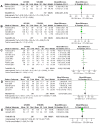Effects of neurostimulation for advanced Parkinson's disease patients on motor symptoms: A multiple-treatments meta-analysas of randomized controlled trials
- PMID: 27142183
- PMCID: PMC4855136
- DOI: 10.1038/srep25285
Effects of neurostimulation for advanced Parkinson's disease patients on motor symptoms: A multiple-treatments meta-analysas of randomized controlled trials
Abstract
Deep brain stimulation (DBS) is the surgical procedure of choice for patients with advanced Parkinson disease (PD). We aim to evaluate the efficacy of GPi (globus pallidus internus), STN (subthalamic nucleus)-DBS and medical therapy for PD. We conducted a systematic review and multiple-treatments meta-analysis to investigate the efficacy of neurostimulation and medical therapy for PD patients. Sixteen eligible studies were included in this analysis. We pooled the whole data and found obvious difference between GPi-DBS versus medical therapy and STN-DBS versus medical therapy in terms of UPDRS scores (Unified Parkinson's Disease Rating Scale). Meanwhile, we found GPi-DBS had the similar efficacy on the UPDRS scores when compared with STN-DBS. What is more, quality of life, measured by PDQ-39 (Parkinson's disease Questionnaire) showed greater improvement after GPi-DBS than STN-DBS. Five studies showed STN-DBS was more effective for reduction in medication than GPi-DBS. Overall, either GPi-DBS or STN-DBS was an effective technique to control PD patients' symptoms and improved their functionality and quality of life. Meanwhile, the UPDRS scores measuring parkinsonian symptoms revealed no significant difference between GPi-DBS and STN-DBS. STN-DBS was more effective for reduction in medication than GPi-DBS. Alternatively, GPi-DBS was more effective for improving the PDQ-39 score than STN-DBS.
Figures






Similar articles
-
Motor outcomes in unilateral, bilateral rapid, and bilateral delayed staging deep brain stimulation for Parkinson's disease.J Parkinsons Dis. 2024 Nov;14(8):1614-1622. doi: 10.1177/1877718X241296014. Epub 2024 Dec 8. J Parkinsons Dis. 2024. PMID: 39957194
-
Subthalamic nucleus and globus pallidus internus stimulation for the treatment of Parkinson's disease: A systematic review.J Int Med Res. 2017 Oct;45(5):1602-1612. doi: 10.1177/0300060517708102. Epub 2017 Jul 12. J Int Med Res. 2017. PMID: 28701061 Free PMC article.
-
Subthalamic and nigral stimulation for freezing of gait in Parkinson's disease: Randomized pilot trial.J Parkinsons Dis. 2024 Nov;14(8):1602-1613. doi: 10.1177/1877718X241292315. Epub 2025 Jan 17. J Parkinsons Dis. 2024. PMID: 39957196 Clinical Trial.
-
Modulation of Cerebellar Oscillations with Subthalamic Stimulation in Patients with Parkinson's Disease.J Parkinsons Dis. 2024;14(7):1417-1426. doi: 10.3233/JPD-240065. J Parkinsons Dis. 2024. PMID: 39331106 Free PMC article.
-
Subthalamic nucleus deep brain stimulation: summary and meta-analysis of outcomes.Mov Disord. 2006 Jun;21 Suppl 14:S290-304. doi: 10.1002/mds.20962. Mov Disord. 2006. PMID: 16892449
Cited by
-
The long-term efficacy of STN vs GPi deep brain stimulation for Parkinson disease: A meta-analysis.Medicine (Baltimore). 2018 Aug;97(35):e12153. doi: 10.1097/MD.0000000000012153. Medicine (Baltimore). 2018. PMID: 30170458 Free PMC article. Review.
-
Effects of mGluR5 Antagonists on Parkinson's Patients With L-Dopa-Induced Dyskinesia: A Systematic Review and Meta-Analysis of Randomized Controlled Trials.Front Aging Neurosci. 2018 Sep 11;10:262. doi: 10.3389/fnagi.2018.00262. eCollection 2018. Front Aging Neurosci. 2018. PMID: 30271338 Free PMC article.
-
Complex therapies for advanced Parkinson's disease: what is the role of doctor-patient communication?Neurol Sci. 2019 Nov;40(11):2357-2364. doi: 10.1007/s10072-019-03982-5. Epub 2019 Jun 28. Neurol Sci. 2019. PMID: 31254180
-
Parkinson's Disease: Personalized Pathway of Care for Device-Aided Therapies (DAT) and the Role of Continuous Objective Monitoring (COM) Using Wearable Sensors.J Pers Med. 2021 Jul 19;11(7):680. doi: 10.3390/jpm11070680. J Pers Med. 2021. PMID: 34357147 Free PMC article. Review.
-
Feature visualization and classification for the discrimination between individuals with Parkinson's disease under levodopa and DBS treatments.Biomed Eng Online. 2016 Dec 30;15(1):169. doi: 10.1186/s12938-016-0290-y. Biomed Eng Online. 2016. PMID: 28038673 Free PMC article.
References
-
- Vidailhet M. Movement disorders in 2010: Parkinson disease-symptoms and treatments. Nat Rev Neurol 7, 70–72 (2011). - PubMed
-
- Jankovic J. & Sherer T. The future of research in Parkinson disease. JAMA Neurol 71, 1351–1352 (2014). - PubMed
-
- Velseboer D. C. et al. Prognostic factors of motor impairment, disability, and quality of life in newly diagnosed PD. Neurology 8, 627–633 (2013). - PubMed
-
- Malkki H. Parkinson disease: deep brain stimulation might alleviate parkinsonism by reducing excessive synchronization in primary motor cortex. Nat Rev Neurol 11, 246 (2015). - PubMed
-
- Li Q., Qian Z. M., Arbuthnott G. W., Ke Y. & Yung W. H. Cortical effects of deep brain stimulation: implications for pathogenesis and treatment of Parkinson disease. JAMA Neurol 71, 100–103 (2014). - PubMed
Publication types
MeSH terms
LinkOut - more resources
Full Text Sources
Other Literature Sources
Medical

